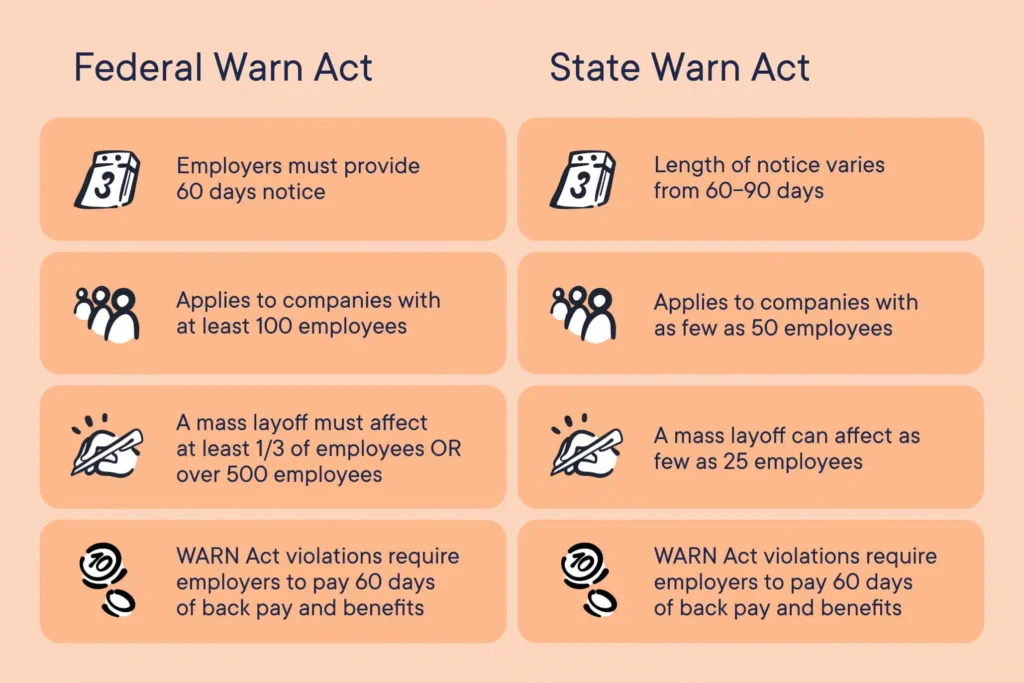
WARN Act California: Requirements, Coverage, and Compliance
August 08, 2025 Written by Rafael Spuldar

Preparing for a RIF?
Download our Essential Guide to Handling a Layoff
Request Pricing
Compare our rates to other providers
If you plan to lay off employees in the state of California, you must ensure compliance with all regulations related to the Worker Adjustment and Retraining Notification Act (commonly known as the WARN Act). This will ensure that your employees are treated fairly and that you are not penalized for your layoff or reduction in force (RIF) event.
To understand how to comply with the WARN Act in California in 2025 (and beyond), we will look at three different areas:
- The federal WARN Act requirements
- The state-specific WARN Act requirements in California
- How to comply with WARN Act California laws
Before we dig into our analysis for each of these areas, make sure to download our simple WARN Act checklist with the link below:
What Are the Federal WARN Act Regulations?
The WARN Act has several regulations that shape who the law should be applied to. This includes the following stipulations:
- The WARN Act applies to your organization if you have over 100 full-time employees.
- The WARN Act applies to all publicly and privately held companies.
- The WARN Act applies to all organizations, whether for-profit or not-for-profit.
- A WARN notice must be given if there is a plant closing or a mass layoff.
The first three stipulations are relatively straightforward. The final stipulation, however, relies on the federal definitions of a “plant closing” and a “mass layoff,” which may differ from those set at the state level. We’ll get into that distinction for the state of California in a minute.
To comply with the WARN Act at the federal level, you must send a WARN notice to your affected employees 60 days in advance of their last day with the organization. To fully comply with the WARN Act, your organization must also notify the government about the reduction event. This notice must also be sent 60 days in advance to your state dislocated worker unit, as well as to the chief elected official of the local government in which your employment site is located.
Now, let’s dive into the state-specific requirements for the WARN Act in California and how they compare to the federal regulations above.

What Is the California WARN Act?
As explained above, there are federal regulations resulting from the WARN Act that all states are required to comply with. In addition to that, some states also have more stringent regulations specific to the companies located in their state (as well as for employees working in that state, such as remote workers).
California is among those states with tighter regulations that companies must follow. Let’s discuss each of the specific regulations that companies located in California (or with employees working in California) must follow to comply with the WARN Act in that state and how they compare to their federal counterparts.
How Many Employees Trigger the California WARN Act?
Like other states that differ from federal regulations, California has different requirements based on employee size and the number of employees impacted. According to the California Employment Development Department (EDD), this distinction on covered employers is:
“Applicable to a ‘covered establishment’ that employs or has employed in the preceding 12 months, 75 or more full and part-time employees. As under the federal WARN, employees must have been employed for at least 6 months of the 12 months preceding the date of required notice in order to be counted.”
As you can see, the CA WARN Act threshold for notification requirements is slightly lower than federal regulations, which pertain to employers with over 100 full-time employees.
What Is the Difference Between Federal and California WARN Act Definitions?
In California, the definitions for mass layoffs and plant closings are considerably simpler than at the federal level. In the words of the California EDD, these definitions include:
“Plant closure affecting any amount of employees. Layoff of 50 or more employees within a 30-day period regardless of percent of workforce. Relocation of at least 100 miles affecting any amount of employees.”
In other words, mass layoffs encompass all layoffs that occur within any 30-day period involving 50 or more employees. For plant closings, all such events will trigger the CA WARN Act, regardless of the number of employees affected.
At the federal level, in comparison, the US Department of Labor applies the WARN Act to all mass layoffs that “will result in an employment loss at the employment site during any 30-day period for 500 or more employees, or for 50-499 employees if they make up at least 33% of the employer’s active workforce,” as well as plant closings that “will result in an employment loss (as defined later) for 50 or more employees during any 30 day period.”
What Is the WARN Act Penalty in California?
The federal government penalizes businesses that do not comply with the WARN Act by forcing them to provide back pay and benefits to employees for as long as the business is in violation.
Per the CA EDD, California takes this penalty a step further:
“A possible civil penalty of $500 a day for each day of violation. Employees may receive back pay to be paid at employee’s final rate or 3-year average rate of compensation, whichever is higher. In addition, employer is liable for cost of any medical expenses incurred by employees that would have been covered under an employee benefit plan.
The employer is liable for period of violation up to 60 days or one-half the number of days the employee was employed, whichever period is smaller.”
WARN Act California Examples
To help clarify how the California WARN Act works in real life, here are some real-world examples of situations where the state WARN Act would apply:
Example 1
A tech company in San Jose is planning to relocate one of its offices to Nevada. Although only 25 employees are affected, the relocation is over 100 miles away. Because the move exceeds 100 miles and any number of affected employees triggers the WARN Act in California, a WARN notice is required.
Example 2
A logistics company with 600 employees in Southern California is permanently closing a distribution center in Riverside. This action will result in 78 employees losing their jobs. Since this is a plant closure involving any number of employees, the company must issue a WARN notice in California at least 60 days in advance.
Example 3
A food processing plant in the Central Valley lays off 52 workers over a 30-day period due to a downturn in demand. Even though the layoffs are spread out, they occur within a 30-day window and involve 50 or more employees. Therefore, a WARN notice is required under California law.
These examples show that California’s WARN Act has a lower threshold and broader triggers than the federal version. It’s not just the total number of employees a business has, but also the number of affected workers, the nature of the layoff or closure, and even how far a facility is relocating.
How to Comply with the WARN Act in California
To remain compliant with the WARN Act in California, employers must provide written notice at least 60 days prior to a mass layoff, plant closure, or relocation. Notices must be sent to several recipients:
- Affected employees (or their representatives)
- The California Employment Development Department (EDD)
- The Local Workforce Development Board
- The chief elected government official of each city and county affected
The notice must be in writing and clearly state the nature of the layoff or closure. Be sure to include:
- Whether the layoff is permanent or temporary
- The expected date of the first job loss and the schedule of layoffs
- A statement about bumping rights, if applicable
- Contact information for a company representative
- Information about available severance packages or continued benefits, if any
Employers should also keep in mind that notices must be direct and timely. Including them with paychecks or in other bulk communications may not meet compliance standards. Additionally, if the layoff affects remote workers who report to a California office, the WARN Act still applies.
Failing to comply with the WARN notice California requirement can lead to serious penalties, including civil fines and employee claims for back pay and benefits. It’s best to plan early, communicate clearly, and consult your legal team to ensure that everything is in order.
Other State Laws Impacting Your Layoffs
California’s WARN Act isn’t the only regulation you need to be aware of during layoffs. Other state labor laws can influence how your layoff is executed and what benefits must be provided.
For example, California law requires final paychecks—including unused vacation or paid time off (PTO)—to be paid immediately upon termination. In mass layoffs, this applies to every affected employee and must be factored into your planning.
Also, if your layoffs impact employees on protected leave (such as military leave, or maternity leave under the California Family Rights Act), you must ensure that these individuals are not targeted in a way that violates anti-discrimination laws.
Another relevant law is California’s mini-COBRA coverage requirement. If your business has between 2 and 19 employees and offers health insurance, you must notify laid-off employees about their right to continue coverage for up to 36 months.
Lastly, if your organization has employees in other states, you must also consider those states’ laws, which may differ significantly. For multi-state employers, it’s best to follow the most stringent set of requirements to ensure compliance across the board.
By understanding how these laws interact with the WARN Act, you can execute layoffs in a way that protects both your business and your employees while avoiding costly penalties.
WARN Act California: Key Takeaways
The federal WARN Act sets the foundation, but California has additional laws that provide greater protections during layoffs and closures. Because these rules evolve, it’s essential to check the California EDD website regularly. If your business operates in California, consult your legal team before any workforce reduction to ensure full compliance with state, local, and federal requirements.
For information on the specific WARN Act requirements in other states that may apply to your organization, see our similar WARN Act guides for states such as New York, New Jersey, Illinois, Pennsylvania, and Florida.
Offering outplacement services during a plant closure or mass layoff can ease employee transitions and address potential challenges. Click below to connect with our experts and learn more about our industry-leading services, as well as determine the best solutions for your organization to ensure a smooth and compliant layoff process in California.
In need of outplacement assistance?
At Careerminds, we care about people first. That’s why we offer personalized talent management solutions for every level at lower costs, globally.



